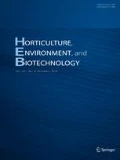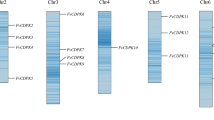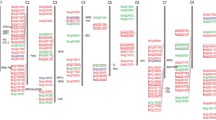Abstract
Malectin-like domain-containing receptor-like kinases (MRLKs) compose a big and diverse protein family in plants that plays significant roles in biotic and abiotic stress response. However, the MRLK family members in Citrus, as well as their roles during drought stress (abiotic stress) and arbuscular mycorrhizal fungi (AMF) colonization, remain relatively unknown. In the present study, we characterized the MRLK family genes in Citrus. By analyzing the presence of malectin-like domains and searching through the Citrus genome, we identified 47 CsMRLKs located within nine chromosomes, with most CsMRLKs mainly located on chromosome 1. These 47 CsMRLK family members were classified into 6 subfamilies with distinct malectin domains. Gene expression analysis showed that all 47 CsMRLKs were expressed in the roots and exhibited differential expression patterns. During the drought stress response, CsMRLK6, 7, 8, 9, 10, 11, 19, 25, 26, and 40 were downregulated. AMF colonization downregulated the expression of CsMRLK6, 10, 11, 12, 14, 17, 20, 30, 35, 43, and 47 and upregulated the expression of CsMRLK2, 5, 13, 21, 22, 28, 29, 32, 38, 41, 45, and 46. In addition, AMF colonization and drought stress showed a synergistic effect, in which the downregulated genes became even more weakened and the upregulated genes became even more enhanced. The present study offers useful perception into the Citrus MRLK gene family and its responses in AMF colonization and drought stress.






Similar content being viewed by others
References
Antolín-Llovera M, Petutsching EK, Ried MK, Lipka V, Nürnberger T, Robatzek S, Parniske M (2014a) Knowing your friends and foes–plant receptor-like kinases as initiators of symbiosis or defense. New Phytol 204:791–802
Antolín-Llovera M, Ried MK, Parniske M (2014b) Cleavage of the SYMBIOSIS RECEPTOR-LIKE KINASE ectodomain promotes complex formation with Nod factor receptor 5. Curr Biol 24:422–427
Boisson-Dernier A, Kessler SA, Grossniklaus U (2011) The walls have ears: the role of plant CrRLK1Ls in sensing and transducing extracellular signals. J Exp Bot 62:1581–1591
Capoen W, Goormachtig S, De Rycke R, Schroeyers K, Holsters M (2005) SrSymRK, a plant receptor essential for symbiosome formation. P Natl Acad Sci USA 102:10369–10374
Chen C, Xia R, Chen H, He YT (2018) A toolkit for biologists integrating various HTS-data handling tools with a user-friendly interface. bioRxiv. https://doi.org/10.1101/289660
Deslauriers SD, Larsen PB (2010) FERONIA is a key modulator of brassinosteroid and ethylene responsiveness in Arabidopsis hypocotyls. Mol Plant 3:626–640
Edgar RC (2004) MUSCLE: multiple sequence alignment with high accuracy and high throughput. Nucleic Acids Res 32:1792–1797
Franck CM, Westermann J, Boisson-Dernier A (2018) Plant malectin-like receptor kinases: from cell wall integrity to immunity and beyond. Annu Rev Plant Biol 69:301–328
Gachomo EW, Baptiste LJ, Kefela T, Saidel WM, Kotchoni SO (2014) The Arabidopsis CURVY1 (CVY1) gene encoding a novel receptor-like protein kinase regulates cell morphogenesis, flowering time and seed production. BMC Plant Biol 14:221
Gasteiger E, Gattiker A, Hoogland C, Ivanyi I, Appel RD, Bairoch A (2003) Expasy: the proteomics server for in-depth protein knowledge and analysis. Nucleic Acids Res 31:3784–3788
Gobbato E (2015) Recent developments in arbuscular mycorrhizal signaling. Curr Opin Plant Biol 26:1–7
Guo H, Li L, Ye H, Yu X, Algreen A, Yin Y (2009) Three related receptor-like kinases are required for optimal cell elongation in Arabidopsis thaliana. P Natl Acad Sci USA 106:7648–7653
Guo H, Nolan TM, Song G, Liu S, Xie Z, Chen J, Schnable PS, Walley JW, Yin Y (2018) FERONIA receptor kinase contributes to plant immunity by suppressing jasmonic acid signaling in Arabidopsis thaliana. Curr Biol 28:3316–3324
Hématy K, Höfte H (2008) Novel receptor kinases involved in growth regulation. Curr Opin Plant Biol 11:321–328
Hématy K, Sado PE, Van Tuinen A, Rochange S, Desnos T, Balzergue S, Pelletier S, Renou J, Höfte H (2007) A receptor-like kinase mediates the response of Arabidopsis cells to the inhibition of cellulose synthesis. Curr Biol 17:922–931
Hok S, Danchin EG, Allasia V, Panabieres F, Attard A, Keller H (2011) An Arabidopsis (malectin-like) leucine-rich repeat receptor-like kinase contributes to downy mildew disease. Plant Cell Environ 34:1944–1957
Indrasumunar A, Wilde J, Hayashi S, Li D, Gresshoff PM (2015) Functional analysis of duplicated Symbiosis Receptor Kinase (SymRK) genes during nodulation and mycorrhizal infection in soybean (Glycine max). J Plant Physiol 176:157–168
Jing X, Shalmani A, Zhou M, Shi P, Muhammad I, Shi Y, Sharif R, Li W, Liu W, Chen K (2020) Genome-wide identification of malectin/malectin-like domain containing protein family genes in rice and their expression regulation under various hormones, abiotic stresses, and heavy metal treatments. J Plant Growth Regul 39:492–506
Kanaoka MM, Torii KU (2010) FERONIA as an upstream receptor kinase for polar cell growth in plants. Proc Natl Acad Sci USA 107:17461–17462
Keinath NF, Kierszniowska S, Lorek J, Bourdais G, Kessler SA, Shimosato-Asano H, Grossniklaus U, Schulze WX, Robatzek S, Panstruga R (2010) PAMP (pathogen-associated molecular pattern)-induced changes in plasma membrane compartmentalization reveal novel components of plant immunity. J Biol Chem 285:39140–39149
Kessler SA, Shimosato-Asano H, Keinath NF, Wuest SE, Ingram G, Panstruga R, Grossniklaus U (2010) Conserved molecular components for pollen tube reception and fungal invasion. Science 330:968–971
Kessler SA, Lindner H, Jones DS, Grossniklaus U (2015) Functional analysis of related CrRLK1L receptor-like kinases in pollen tube reception. EMBO Rep 16:107–115
Kumar S, Stecher G, Tamura K (2016) MEGA7: molecular evolutionary genetics analysis version 7.0 for bigger datasets. Mol Biol Evol 33:1870–1874
Liao H, Tang R, Zhang X, Luan S, Yu F (2017) FERONIA receptor kinase at the crossroads of hormone signaling and stress responses. Plant Cell Physiol 58:1143–1150
Lindner H, Müller LM, Boisson-Dernier A, Grossniklaus U (2012) CrRLK1L receptor-like kinases: not just another brick in the wall. Curr Opin Plant Biol 15:659–669
Livak KJ, Schmittgen TD (2001) Analysis of relative gene expression data using real-time quantitative PCR and the 2−ΔΔCT method. Methods 25:402–408
Mao D, Yu F, Li J, Van de Poel B, Tan D, Li J, Liu Y, Li X, Dong M, Chen L, Li D, Luan S (2015) FERONIA receptor kinase interacts with S-adenosylmethionine synthetase and suppresses S-adenosylmethionine production and ethylene biosynthesis in Arabidopsis. Plant Cell Environ 38:2566–2574
Miyazaki S, Murata T, Sakurai-Ozato N, Kubo M, Demura T, Fukuda H, Hasebe M (2009) ANXUR1 and 2, sister genes to FERONIA/SIRENE, are male factors for coordinated fertilization. Curr Biol 19:1327–1331
Nissen KS, Willats WG, Malinovsky FG (2016) Understanding CrRLK1L function: cell walls and growth control. Trends Plant Sci 21:516–527
Qu S, Zhang X, Song Y, Lin J, Shan X (2017) THESEUS1 positively modulates plant defense responses against Botrytis cinerea through GUANINE EXCHANGE FACTOR4 signaling. J Integr Plant Biol 59:797–804
Ringli C (2010) Monitoring the outside: cell wall-sensing mechanisms. Plant Physiol 153:1445–1452
Schallus T, Jaeckh C, Fehér K, Palma AS, Liu Y, Simpson JC, Mackeen M, Stier G, Gibson TJ, Feizi T, Pieler T, Muhle-Goll C (2008) Malectin: a novel carbohydrate-binding protein of the endoplasmic reticulum and a candidate player in the early steps of protein N-glycosylation. Mol Biol Cell 19:3404–3414
Schoenaers S, Balcerowicz D, Breen G, Hill K, Zdanio M, Mouille G, Holman TJ, Oh J, Wilson MH, Nikonorova N, Vu LD, Smet ID, Swarup R, De Vos WH, Pintelon I, Adriaensen D, Grierson C, Bennett MJ, Vissenberg K (2018) The auxin-regulated CrRLK1L kinase ERULUS controls cell wall composition during root hair tip growth. Curr Biol 28:722–732
Seifert GJ, Blaukopf C (2010) Irritable walls: the plant extracellular matrix and signaling. Plant Physiol 153:467–478
Shih H, Miller ND, Dai C, Spalding EP, Monshausen GB (2014) The receptor-like kinase FERONIA is required for mechanical signal transduction in Arabidopsis seedlings. Curr Biol 24:1887–1892
Shiu SH, Bleecker AB (2001) Receptor-like kinases from Arabidopsis form a monophyletic gene family related to animal receptor kinases. Proc Natl Acad Sci USA 98:10763–10768
Shu B, Xia RX, Wang P (2012) Differential regulation of Pht1 phosphate transporters from trifoliate orange (Poncirus trifoliata L. Raf) seedlings. Sci Hortic-Amsterdam 146:115–123
Shu B, Li WC, Liu LQ, Wei YZ, Shi SY (2016) Transcriptomes of arbuscular mycorrhizal fungi and litchi host interaction after tree girdling. Front Microbiol 7:408
Stegmann M, Monaghan J, Smakowska-Luzan E, Rovenich H, Lehner A, Holton N, Belkhadir Y, Zipfel C (2017) The receptor kinase FER is a RALF-regulated scaffold controlling plant immune signaling. Science 355:287–289
Steinwand BJ, Kieber JJ (2010) The role of receptor-like kinases in regulating cell wall function. Plant Physiol 153:479–484
Tan Z, Hu Y, Lin Z (2013) Expression of SYMRK affects the development of arbuscular mycorrhiza in tobacco roots. Acta Physiol Plant 35:85–94
Wang Y, Tang H, DeBarry JD, Tan X, Li J, Wang X, Lee T, Jin H, Marler B, Guo H, Kissinger JC, Paterson AH (2012) MCScanX: a toolkit for detection and evolutionary analysis of gene synteny and collinearity. Nucleic Acids Res 40:e49–e49
Wolf S, Hématy K, Höfte H (2012) Growth control and cell wall signaling in plants. Annual Rev Plant Biol 63:381–407
Yang T, Wang L, Li C, Liu Y, Zhu S, Qi Y, Liu X, Lin Q, Luan S, Yu F (2015) Receptor protein kinase FERONIA controls leaf starch accumulation by interacting with glyceraldehyde-3-phosphate dehydrogenase. Biochem Bioph Res Commun 465:77–82
Yu F, Li J, Huang Y, Liu L, Li D, Chen L, Luan S (2014) FERONIA receptor kinase controls seed size in Arabidopsis thaliana. Mol Plant 7:920–922
Zhang Q, Jia M, Xing Y, Qin L, Li B, Jia W (2016) Genome-wide identification and expression analysis of MRLK family genes associated with strawberry (Fragaria vesca) fruit ripening and abiotic stress responses. PLoS ONE 11:e0163647
Zhang F, Zou YN, Wu QS, Kuča K (2019) Arbuscular mycorrhizas modulate root polyamine metabolism to enhance drought tolerance of trifoliate orange. Environ Exp Bot 171:103926
Acknowledgements
This work was supported by the Scientific Research Foundation for doctor of Yangtze University (No. 802100270303).
Author information
Authors and Affiliations
Contributions
Chun Luo: conceived the experiments and wrote the manuscript. Chun Luo, Bo Shu, Fei Zhang: carried out the experiments. Chun Luo, Qiaofeng Sun, Dejian Zhang, Chunyan Liu: analyzed the data. Qiangsheng Wu, Bo Shu: critically reviewed the manuscript.
Corresponding author
Ethics declarations
Conflict of interest
The authors declare no conflict of interest.
Additional information
Communicated by Cecile Segonzac.
Publisher's Note
Springer Nature remains neutral with regard to jurisdictional claims in published maps and institutional affiliations.
Electronic supplementary material
Below is the link to the electronic supplementary material.
Supplementary Fig. S1
Phylogenetic tree of CsMRLK proteins and four other SYMRK proteins (TIFF 1106 kb)
Supplementary Fig. S2
Analysis and distribution of conserved motifs in CsMRLK proteins. (TIFF 2842 kb)
Supplementary Table S1
Primer sequences used for qRT-PCR analysis. (DOCX 14 kb)
Supplementary Table S2
Fragments per kilobase of exon model per million mapped reads (FPKM) values of each treatment. (XLSX 18 kb)
Rights and permissions
About this article
Cite this article
Luo, C., Sun, Q., Zhang, F. et al. Genome-wide identification and expression analysis of the Citrus malectin domain-containing receptor-like kinases in response to arbuscular mycorrhizal fungi colonization and drought. Hortic. Environ. Biotechnol. 61, 891–901 (2020). https://doi.org/10.1007/s13580-020-00273-3
Received:
Revised:
Accepted:
Published:
Issue Date:
DOI: https://doi.org/10.1007/s13580-020-00273-3




